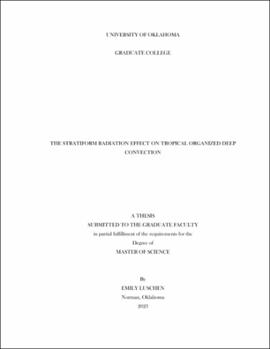| dc.description.abstract | Idealized studies of self-aggregation have implicated the importance of longwave (LW) cloud-radiative forcing (CRF) in facilitating the upscale development of moist convection. While different cloud structures are known to have distinct CRF, the relative role of distinct cloud and precipitation types in driving upscale development through radiative feedback is largely unexplored. Considering the impact CRF has on convection, we hypothesize that different cloud modes have different effects on mesoscale tropical convection through radiative feedback. We test this hypothesis by analyzing output from Weather Research and Forecasting (WRF) model simulations of Super Typhoon Haiyan. Using a novel column-by-column precipitation classification scheme, we use this model output to identify the relative contribution of 5 cloud types to the direct LW radiative forcing and the upscale development of convection via LW moist static energy variance. Results indicate that stratiform and anvil regions contribute dominantly to the domain averages of these variables.
We next compared the control simulation (CTL) to sensitivity tests that exclude cloud-radiative feedback (NCRF) either everywhere or only in specific cloud types. These tests indicate that the upscale development of deep convection that manifests in tropical cyclone (TC) genesis is accelerated by CRF, especially of that in stratiform regions. There is a growing consensus from observations that the areal growth of stratiform precipitation is a key precursor to TC genesis and intensification. This observational finding presents a conundrum, given that stratiform precipitation is directly tied to downdrafts, and hence ventilation. Therefore, we hypothesize that the cloud-radiative effect within stratiform cloud regions weakens downdrafts, allowing the environment to moisten more easily. Analysis shows that CTL tests have less downward vertical mass flux in the mid to lower troposphere, indicating weaker (and/or fewer) downdrafts, than that of the NCRF tests, with the greatest differences being in stratiform regions. These findings support our hypothesis that cloud-radiative effects in the stratiform regions weaken downdrafts in developing TCs, in turn allowing the environment to moisten more easily. Understanding the importance of cloud type CRF, especially that of stratiform, could provide insight on the development of tropical convection and TC genesis. | en_US |

